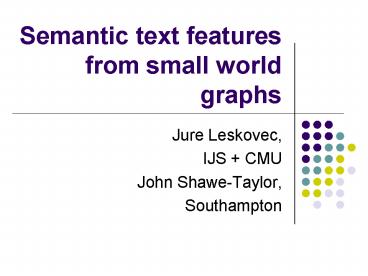Semantic text features from small world graphs - PowerPoint PPT Presentation
1 / 18
Title:
Semantic text features from small world graphs
Description:
Semantic text features from small world graphs. Jure Leskovec, IJS CMU. John Shawe-Taylor, ... We usually treat text documents as bags of words sparse ... – PowerPoint PPT presentation
Number of Views:40
Avg rating:3.0/5.0
Title: Semantic text features from small world graphs
1
Semantic text features from small world graphs
- Jure Leskovec,
- IJS CMU
- John Shawe-Taylor,
- Southampton
2
Introduction
- We usually treat text documents as bags of words
sparse vectors of word counts - To measure document similarity we use cosine
similarity (the inner product) - Bag-of-words does not capture any semantics
- Word frequencies follow a power-law distribution
- The IDF weighting compensates for skewed
distribution - To reach over the bag of words people have
proposed various techniques LSI friends,
string kernels, semantic kernels, ... - In small world graphs we also observe power laws
- We investigate a few first steps in creating
ad-hoc small world graphs to model word
generation and hence measure feature similarity
3
The general idea
- Given a set of text units (documents, paragraphs)
- Organize them into the a tree or a graph, where
each node contains a set of semantically
related features (words) - We use the topology to measure feature similarity
4
Toy example
- Child extends the vocabulary of a parent
- We expect to find increasingly fine grained
terminology as we move down the tree (graph) - Each node contains a set of (semantically
related) words - Analogy to OpenDirectory a taxonomy of web
pages - Note we are not trying to construct a taxonomy
but just exploit the structure to measure feature
similarity
stop-words
Stats
EE
CS
AI
ML
Robotics
5
The algorithms
- We present the following 3 algorithms for
creating the topologies - Basic Tree
- Optimal Tree
- Basic Graph
6
Algorithm 1 Basic Tree
- Take the documents in random order
- For each document create a node in a tree
- Create a link to parent node Nj where we
maximize - We tested various score functions. The suggested
one performed best. - Each node contains words that are new for the
path from the root to the node
where P(j) parents of Nj
7
Algorithm 1 Basic Tree (2)
- The algorithm
- Compare a blue node to all nodes in the tree
- We measure the score between the words in a new
node and the words on a path from a white node to
the root of the tree - Create a link to a node with the highest score
8
Basic Tree variations
- Introduce a stop words node
- We experimented with several stop words
collections (8, 425, 523 English stop words). - We use 8 stop words
- and, an, by, from, of, the, with
- Also add the words that occur in more than 80 of
the nodes - Usually there are about 20 stop words in the
stop-words node
9
Algorithm 2 Optimal Tree
- The tree created by Basic Tree depends on the
ordering of the documents - We can use a greedy algorithm
- Start with a stop words node
- From the pool of documents pick a document with
maximal score - Create a node for it
- Link to parent as in Basic Tree
10
Algorithm 3 Basic Graph
- Hierarchies are in reality graphs
- For example we expect Machine Learning to extend
vocabulary of both Statistics and Computer
Science - Algorithm
- Start with a stop-words node (we remove it after
the graph is built) - Node contains words that are new for the whole
graph built so far - We link a new node to all nodes where
threshold0.05
11
Feature similarity measure
- Having 2 documents composed of words
- Document similarity is the similarity between all
pairs of words in the 2 documents (expensive
O(N2)) - Having a topology over the features we do not
treat features as independent - We use graph (weighted/unweighted) shortest paths
as a feature distance measure - Given a matrix S where Sij is a similarity of
features i and j. The distance between documents
x and z is given by
12
Experimental setup
- Reuters corpus Volume 1
- 800,000 documents, 103 categories
- We consider 1000 random documents
- 10 fold cross validation
- Evaluate the quality of representation with the
kernel alignment
where Aij1 if documents i and j are from the
same category
Compare distances with-in the class vs. the
distances across the class
13
Experiments (1)
Standard deviation
Node distance since nodes in a graph represent
documents, we can measure similarity directly by
using shortest paths.
14
Experiments (2)
Random 0.538, Cosine bag of words 0.585, Basic
tree 0.598
Average Alignment
Standard deviation
15
Experiments (3)
Average Alignment
Standard deviation
16
Experimental Results
- Summary of experiments
- Random 0.538
- Cosine 0.585
- Basic tree 0.591
- Basic tree stop-words node 0.627
- Optimal tree stop-words node 0.629
- Basic graph 0.628
17
Experimental Results
- Stop-words node improves results
- Dependence on document ordering does not degrade
performance - Optimal Tree performs best
- Feature distance outperforms Node distance
- Using weighted (edge weight 1score) shortest
paths always improves performance by 1.5 - Using paragraphs to build graphs does worse
18
Conclusions and Future directions
- We presented the first steps towards building a
topology to better measure of document similarity - Probabilistic generation mechanism for documents
based on the graph structure - We expect to get power law degree distribution
- This could also motivate the choice of document
similarity measure in a more principled way































